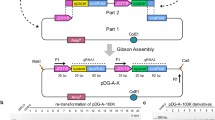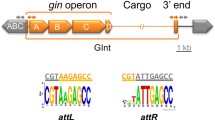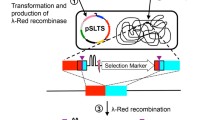Abstract
Inverted repeat and palindromic sequences have the propensity to form non-beta cruciform structures during DNA replication, leading to perturbations within the genome or plasmid replicon. In this study, the tolerance of the Escherichia coli genome to inverted repeat sequences from 25 to 1200 bp was investigated. Genomic inverted repeats were readily created via the homologous insertion of an overlap extension PCR product containing a gene-specific region of the genome together with thyA coding sequence, creating inverted repeat sequences of various lengths flanking the thyA selection marker in the resulting genome. Inverted repeat sequences below 100 bp were stably propagated, while those above and up to 1200 bp were found to be transiently unstable under auxotrophic thymine selection. Excision efficiency improves with increases of the inverted repeat until 600–800 bp, indicating that the genomic stability of inverted repeat sequences is due to secondary structure formation. Its effectiveness of creating precise and scar-free gene deletions was further demonstrated by deleting a number of genes in E. coli. The procedure can be readily adapted for sequence integration and point mutations in E. coli genome. It also has the potential for applications on other bacteria for efficient gene deletions.


Similar content being viewed by others
References
Butler, D. K., Gillespie, D., & Steele, B. (2002). Formation of large palindromic DNA by homologous recombination of short inverted repeat sequences in Saccharomyces cerevisiae. Genetics, 161, 1065–1075.
Cromie, G. A., Millar, C. B., Schmidt, K. H., & Leach, D. R. (2000). Palindromes as substrates for multiple pathways of recombination in Escherichia coli. Genetics, 154, 513–522.
Bikard, D., Loot, C., Baharoglu, Z., & Mazel, D. (2010). Folded DNA in action: hairpin formation and biological functions in prokaryotes. Microbiol Mol Biol Rev, 74, 570–588.
Lobachev, K. S., Rattray, A., & Narayanan, V. (2007). Hairpin-and cruciform-mediated chromosome breakage: causes and consequences in eukaryotic cells. Front Biosci, 12, 4208–4220.
Darmon, E., Eykelenboom, J. K., Lincker, F., Jones, L. H., White, M., Okely, E., Blackwood, J. K., & Leach, D. R. (2010). E. coli SbcCD and RecA control chromosomal rearrangement induced by an interrupted palindrome. Mol Cell, 39, 59––70.
Lobachev, K. S., Shor, B. M., Tran, H. T., Taylor, W., Keen, J. D., Resnick, M. A., & Gordenin, D. A. (1998). Factors affecting inverted repeat stimulation of recombination and deletion in Saccharomyces cerevisiae. Genetics, 148, 1507–1524.
Tran, H. T., Degtyareva, N. P., Koloteva, N. N., Sugino, A., Masumoto, H., Gordenin, D. A., & Resnick, M. A. (1995). Replication slippage between distant short repeats in Saccharomyces cerevisiae depends on the direction of replication and the RAD50 and RAD52 genes. Mol Cell Biol, 15, 5607–5617.
Sinden, R. R., Zheng, G. X., Brankamp, R. G., & Allen, K. N. (1991). On the deletion of inverted repeated DNA in Escherichia coli: effects of length, thermal stability, and cruciform formation in vivo. Genetics, 129, 991–1005.
Zhang, Y., Saini, N., Sheng, Z., Lobachev, K.S. (2013). Genome-wide screen reveals replication pathway for quasi-palindrome fragility dependent on homologous recombination. PLoS Genet. 9. e1003979.
Tsukamoto, Y., Kato, J. I., & Ikeda, H. (1996). Effects of mutations of RAD50, RAD51, RAD52, and related genes on illegitimate recombination in Saccharomyces cerevisiae. Genetics, 142, 383–391.
Leach, D. R., Okely, E. A., & Pinder, D. J. (1997). Repair by recombination of DNA containing a palindromic sequence. Mol Microbiol, 26, 597–606.
Lim, C., A.L., Luhe, C.T., Jing Ying, Balagurunathan, B., Wu, J. and Zhao, H et al. (2013). Size of gene specific inverted repeat - dependent gene deletion in Saccharomyces cerevisiae. PLoS ONE. 8. e72137.
Nair, N.U. and Zhao, H. (2009). Mutagenic inverted repeat assisted genome engineering (MIRAGE). Nucleic Acids Res. 37. e9.
Leach, D. R., & Stahl, F. W. (1983). Viability of lambda phages carrying a perfect palindrome in the absence of recombination nucleases. Nature, 305, 448–451.
Datsenko, K. A., & Wanner, B. L. (2000). One-step inactivation of chromosomal genes in Escherichia coli K-12 using PCR products. Proc Natl Acad Sci USA, 97, 6640–6645.
Werner, J., & Misra, R. (2005). YaeT (Omp85) affects the assembly of lipid-dependent and lipid-independent outer membrane proteins of Escherichia coli. Molecular Microbiology, 57, 1450–1459.
Stringer, A.M., Singh, N., Yermakova, A., Petrone, B.L. and Amarasinghe, J.J. et al. (2012). FRUIT, a scar-free system for targeted chromosomal mutagenesis, epitope tagging, and promoter replacement in Escherichia coli and Salmonella enterica. PLoS ONE. 7. e44841
White, M. A., Eykelenboom, J. K., Lopez-Vernaza, M. A., Wilson, E., & Leach, D. R. (2008). Non-random segregation of sister chromosomes in Escherichia coli. Nature, 455, 1248–1250.
Pinder, D. J., Blake, C. E., Lindsey, J. C., & Leach, D. R. (1998). Replication strand preference for deletions associated with DNA palindromes. Mol Microbiol, 28, 719–727.
Sinden, R. R., HashemI, V. I., & Rosche, W. A. (1999). DNA-directed mutations. Leading and lagging strand specificity. Ann N Y Acad Sci, 870, 173–189.
Shurvinton, C. E., Stahl, M. M., & Stahl, F. W. (1987). Large palindromes in the lambda phage genome are preserved in a rec + host by inhibiting lambda DNA replication. Proc Natl Acad Sci USA, 84, 1624–1628.
Leach, D. R. (1994). Long DNA palindromes, cruciform structures, genetic instability and secondary structure repair. Bioessays, 16, 893–900.
Peters, J. E., Thate, T. E., & Craig, N. L. (2003). Definition of the Escherichia coli MC4100 genome by use of a DNA array. J Bacteriol, 185, 2017–2021.
Kulkarni, S. K., & Stahl, F. W. (1989). Interaction between the sbcC gene of Escherichia coli and the gam gene of phage lambda. Genetics, 123, 249–253.
Marsić, N., Roje, S., Stojiljković, I., Salaj-Smic, E., & Trgovcević, Z. (1993). In vivo studies on the interaction of RecBCD enzyme and lambda Gam protein. J Bacteriol, 175, 4738–4743.
Link, A. J., Phillips, D., & Church, G. M. (1997). Methods for generating precise deletions and insertions in the genome of wild-type Escherichia coli: application to open reading frame characterization. J Bacteriol, 179, 6228––6237.
Hamilton, C. M., Aldea, M., Washburn, B. K., Babitzke, P., & Kushner, S. R. (1989). New method for generating deletions and gene replacements in Escherichia coli. J Bacteriol, 171, 4617–4622.
Yu, D., Ellis, H. M., Lee, E. C., Jenkins, N. A., Copel, N. G., & Court, D. L. (2000). An efficient recombination system for chromosome engineering in Escherichia coli. Proc Natl Acad Sci USA, 97, 5978–5983.
Wong, Q.N., Ng, V.C., Lin, M.C., Kung, H.F., Chan, D. et al. (2005). Efficient and seamless DNA recombineering using a thymidylate synthase: a selection system in Escherichia coli. Nucleic Acids Res. 33. e59.
Pósfai, G., Kolisnychenko, V., Bereczki, Z., & Blattner, F. R. (1999). Markerless gene replacement in Escherichia coli stimulated by a double-strand break in the chromosome. Nucleic Acids Res, 27, 4409–4415.
Yu, B.J., Kang, K.H., Lee, J.H., Sung, B.H., Kim, M.S. and Kim, S.C. (2008). Rapid and efficient construction of markerless deletions in the Escherichia coli genome. Nucleic Acids Res. 36. e84.
Jiang, W., Bikard, D., Cox, D., Zhang, F., & Marraffini, L. A. (2013). RNA-guided editing of bacterial genomes using CRISPR-Cas systems. Nature Biotechnology, 31, 233–239.
Bogdanove, A. J., & Voytas, D. F. (2011). TAL effectors: customizable proteins for DNA targeting. Science, 333, 1843–1846.
Urnov, F. D., Rebar, E. J., Holmes, M. C., Zhang, H. S., & Gregory, P. D. (2010). Genome editing with engineered zinc finger nucleases. Nature Reviews. Genetics, 11, 636–646.
Stearns, T., Ma, H., & Botstein, D. (1990). Manipulating yeast genome using plasmid vectors. Methods Enzymol, 185, 280––297.
Boeke, J., Lacroute, F., & Fink, G. R. (1984). A positive selection for mutants lacking orotidine-5′-phosphate decarboxylase activity in yeast: 5-fluoro-orotic acid resistance. Mol Gen Genet, 197, 345–346.
Güldener, U., Heck, S., Fiedler, T., Beinhauer, J., & Hegemann, J. H. (1996). A new efficient gene disruption cassette for repeated use in budding yeast. Nucleic Acids Res, 24, 2519–2524.
Akada, R., Kitagawa, T., Kaneko, S., Toyonaga, D., Ito, S., Kakihara, Y., Hoshida, H., Morimura, S., Kondo, A., & Kida, K. (2006). PCR-mediated seamless gene deletion and marker recycling in Saccharomyces cerevisiae. Yeast, 23, 399–405.
Noskov, V. N., Segall-Shapiro, T. H., & Chuang, R. Y. (2010). Tandem repeat coupled with endonuclease cleavage (TREC): a seamless modification tool for genome engineering in yeast. Nucleic Acids Res, 38, 2570–2576.
Acknowledgments
We thank the group members of Industrial Biotechnology, Institute of Chemical & Engineering Sciences, for their insights and discussion. This work was funded by A*STAR in Singapore ICES/12-574A01. We thank the reviewer for the comments and constructive criticisms.
Author information
Authors and Affiliations
Corresponding author
Additional information
Crystal Jing Ying Tear and Chanyuen Lim contributed equally.
Electronic supplementary material
Below is the link to the electronic supplementary material.
ESM 1
(DOCX 19 kb)
Rights and permissions
About this article
Cite this article
Tear, C.J.Y., Lim, C. & Zhao, H. Excision of Unstable Artificial Gene-Specific Inverted Repeats Mediates Scar-Free Gene Deletions in Escherichia coli . Appl Biochem Biotechnol 175, 1858–1867 (2015). https://doi.org/10.1007/s12010-014-1402-4
Received:
Accepted:
Published:
Issue Date:
DOI: https://doi.org/10.1007/s12010-014-1402-4




